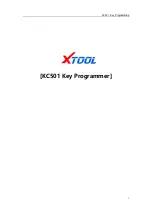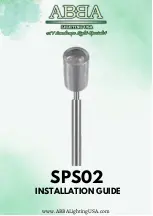
Page 2 of 12
Carefully remove the microbar and place it on a flat surface. Examine the unit for transit damage, and locate all parts. If damage is found, or
parts are missing, contact the transit company or CODE 3. Do not use damaged or broken parts.
Figure 1
Installation and Mounting:
Step 1.
Select the desired location on a flat surface for the microbar to be mounted. The visibility of the flash and ease of wiring access
should be taken into consideration in the selection of the mounting location.
Step 2.
Remove lens screws, then remove lens. Use the four holes in the corners of the base to mark the mounting hole locations.
Step 3.
Drill the holes using a 7/32” drill size.
Step 4.
A fifth hole may be drilled for wire access.
Step 5.
Connect the power wires as shown in the wiring section (see Figure 6).
Step 6.
Mount the microbar with M5 hardware provided.
IMPORTANT! This unit is a safety device and it must be connected to its own separate, fused power point to assure its continued operation
should any other electrical accessory fail.
CAUTION!
When drilling into any vehicle surface, make sure that the area is free from any electrical wires, fuel lines, vehicle upholstery, etc. that
could be damaged.
Permenent Mounting:
Vacuum-Magnet Mounting:
The Vacuum-Magnet Mount feature includes a suction cup on the
bottom of the microbar, with a magnet inside of the suction cup,
for a secure, temporary mount. The microbar should be placed in
the center of the roof where the least amount of curvature occurs.
Before installing, make sure the mounting surface is clean and
there is no debris on the bottom of the microbar or on the roof of the
vehicle, which could reduce the holding power of the suction cup
and magnet. Place and remove the microbar without sliding to avoid
scratching the paint on the vehicle. After placement, the microbar
should adhere firmly to the surface. If the unit slides or moves
easily, a proper installation has not been obtained. To release the
vacuum, lift the tab to release the airlock (see Figure 1). To protect
the Vacuum-Magnet Mount assembly, return microbar to the box
when not in use.
Do not attempt to attach the microbar to an ice-
covered surface.
WARNING!
Maximum recommended vehicle speed for safe operation using the Vacuum Mount model is 65 mph (104 km/h) when fitted to the
center of a vehicle roof of steel construction. Higher speeds could cause the mount to fail, resulting in the minibar flying off of the
vehicle, which could cause damage to other vehicles and injury or death to the passengers. The vacuum-magnet mount is not intended as a
permanent mount for the minibar. The vacuum-magnet mount unit must be mounted on a magnetic surface (i.e. no fiberglass, etc.). Ensure
that the magnet ts kept clean.
Vacuum-Magnet Mount Installation:
Step 1.
Remove lens screws, then remove lens shown in Figure 3.
Step 2.
Unclip and remove wire harness.
Step 3.
Insert the pinned end of the cigarette adapter cable through the wire harness hole from the bottom of the base.
Step 4.
Turn pins crimp side up, and insert pins into connector as shown in Figure 4.
Step 5.
Place zip-tie 1.5” from base of the connector shown in Figure 5. Zip-tie must be not be able to slide on cord. Trim excess zip-tie.
Step 6.
Clip the connector to the PCA board and pull slack until zip-tie touches base.
Step 7.
With the cigarette plug to the left, unscrew the two modules farthest away from you, and the PCA board in dual color versions, to
gain access to the vacuum mounting holes.
Step 8.
Position the vacuum magnet, and secure in place with included hardware.
Step 9.
Re-install the modules, PCA board, and lens, reverse of removal. Slide o-ring onto screw until it reaches head, before securing into
lens.
PULL/ROLL TAB
UPWARD TO RELEASE
VACUUM
Summary of Contents for C5550 Series
Page 9: ...Page 9 of 12 Notes...
Page 10: ...Page 10 of 12 Notes...
Page 11: ...Page 11 of 12 Notes...






























